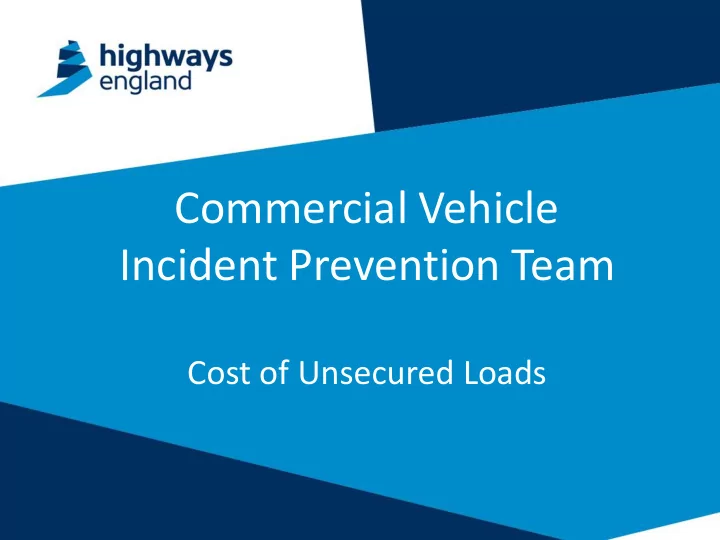

Commercial Vehicle Incident Prevention Team Cost of Unsecured Loads
Mike Higgins Project Manager
Commercial Vehicle Incident Prevention Programme “Reduce HGV KSI collisions on the SRN from 401 (2014 baseline) by 20% (80). To be achievedby 2020 ” KSI = Killed and Seriously Injured SRN = Strategic Road Network
Projects and Interventions
Shed Load Incidents on the Strategic Road Network Between 1 st November 2017 and 31 st October 2018: • 535 Shed Load Incidents • 255 impacted a running lane • Avg. 1h 39min lane closure per incident • Longest duration incident: 72hrs 33mins due to infrastructure damage requiring emergency roadworks
Ratchet Straps and Debris • 4,824 incidents involving ratchet straps • 56,827 incidents of an item obstructing the carriageway.
The Economic Cost (DfT Figures) Duration of incident closure Lanes closed (of 4) 15 minutes 30 minutes 1 hour 2 hours 3 hours 4 hours Flow (% of capacity) 1 £176 £705 £2,820 £11,280 £25,380 £45,120 2 £2,115 £8,460 £33,840 £135,360 £304,560 £541,440 80 (Busy) 3 £5,816 £23,265 £93,060 £372,240 £837,540 £1,488,960 4 £11,280 £45,120 £180,480 £721,920 £1,624,320 £2,887,680 1 - - - - - - 2 £353 £1,410 £5,640 £22,560 £50,760 £90,240 3 £1,851 £7,403 £29,610 £118,440 £266,490 £473,760 60 (Moderate) 4 £4,230 £16,920 £67,680 £270,720 £609,120 £1,082,880 1 - - - - - - 2 - - - - - - 3 £529 £2,115 £8,460 £33,840 £76,140 £135,360 40 (Quiet) 4 £1,880 £7,520 £30,080 £120,320 £270,720 £481,280
Load Security Interventions • Load Security Research • In collaboration with HSL • Working groups with industry professionals • Specific focus on issues with ratchet straps • Police Load Security Training • Designed and delivered by HSL • 9 forces trained • Traffic Officer Service Intelligence Sharing with DVSA • Electronic data exchange • Ability to share information on poorly loaded vehicles in near real time. • Ratchet Strap Guidance Leaflet • Basic Information for drivers on the correct use of straps. • Issued at events and by agencies at the roadside • Load Security Enforcement Pilot with West Yorks. Police and the HSE
And finally, the international perspective….…
Any Questions?
Highways England Traffic Officer Service Freight Related Debris & Incidents
Todays Presentation by Traffic Officer 7309 Andy Binns
Introduction ➢ Our aim today is to show you the types of LGV related debris typically found on England’s Motorway and All Purpose Trunk Road, (APTR), network and it’s effects. ➢ How Highways England Regional Control Centres deal with debris reports. ➢ The hazards to all other motorway travellers. ➢ The dangers confronting Traffic Officers dealing with this debris. ➢ When things go wrong. ➢ Working with Stakeholder Partners. ➢ Return to normality.
England’s Motorways & All Purpose Trunk Roads.
A Regional Control Centre.
➢ RCC’s receive information about debris on network via the travelling public, police and traffic officer active patrolling. ➢ Traffic officers are updated via airwave radio of location, direction on a motorway and the type of debris to be dealt with. ➢ Controllers are able to set speed limits and warning signs on the network to inform the travelling public. ➢ National and local media, Twitter etc, can be used to relay the information to motorists quickly, updates to the Highways England app and internet are also promptly updated.
➢ National and local media, Twitter and the Highways England App can be updated via the RCC, to inform motorists of what’s ahead. Traffic highlighted in RED.
Truck related debris hazards to all other motorway travellers. ➢ Tyre debris. ➢ Insecure / lost loads. ➢ Body and chassis parts. ➢ Securing equipment - i.e. straps, hooks, ratchets, chains etc.
Typical Truck related debris.
➢ What COULD happen after a lost load, vehicle part or securing equipment ends up on the carriage way ?
Hazards to Traffic Officers dealing with live lane debris. ➢ Fast moving traffic. ➢ Adverse weather. ➢ Motorists not paying attention to road signs and warnings of what’s ahead. ➢ Motorists using mobile devises and navigation etc. ➢ Congestion or lack of congestion.
Traffic Officers collecting debris. Rolling road block. Blocked carriageway. Hand stopped traffic.
Traffic Officers use various methods to collect debris. ➢ Rolling road blocks (preferred and safest method in fast moving traffic). Traffic Officers will slow traffic down using a rolling road block over a 2km distance bringing traffic to a stop safely and moving the debris before releasing traffic. ➢ Collecting on foot from the hard shoulder is rare as the unpredictability of motorists is a high risk. This might only be a collection method on a very lightly trafficked Motorway with a Hard Shoulder or at night when there is no traffic. ➢ Hand stop traffic (preferred method in very slow and congested traffic). In very high congestion where speed is below 15 mph traffic officers may stop vehicles by hand and then go on to remove any debris before releasing traffic.
Working alongside Stakeholder Partners.
LGV RTC. A recent lost load resulting in a minor road traffic collision. ➢ 3:50 am Sunday morning. ➢ Junction 35-36 A1M. ➢ Fatigued driver falling asleep. ➢ Vehicle drifts to near side verge. ➢ Driver suddenly is alerted. ➢ Swerves truck away from verge. ➢ Looses control of the truck due to movement of insecure load. ➢ Result is lost load, ripped out roof bars, ripped out torsion bar and ripped off curtain side. ➢ Driver failed to stop at scene. ➢ A1M completely blocked North bound. ➢ Incident results in two vehicles taking avoiding action and colliding with each other ➢ Full closure of motorway for over 5 hours due to clean up.
Return to normality. Traffic Officers display ‘THANK YOU’ to motorway users and release the rolling road block in a timely manner. Signs on the motorway are reset by the RCC and media are informed. Traffic resumes normal flow.
Recommend
More recommend